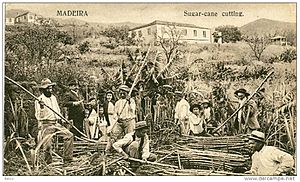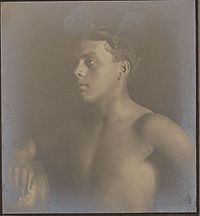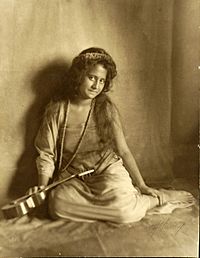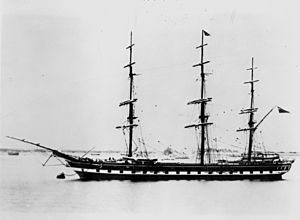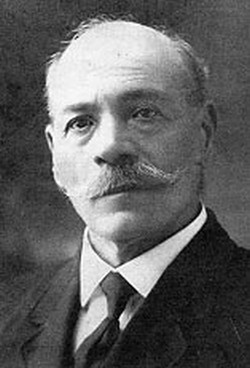Portuguese immigration to Hawaii facts for kids
 
Flags of the Azores and Madeira
|
|
| Total population | |
|---|---|
| 4.3% of Hawaiians in 2008 claimed Portuguese ancestry |
|
| Languages | |
| Portuguese, English, Hawaiian | |
| Religion | |
| Roman Catholic |
Portuguese people started moving to Hawaii in 1878. They came from islands like Madeira and the Azores to work on big sugarcane farms called plantations. By 1911, almost 16,000 Portuguese people had made Hawaii their new home.
Contents
Why Portuguese People Moved to Hawaii
In 1878, only a small number of Portuguese people lived in Hawaii, about 438 out of nearly 58,000 residents. Most were from the Azores or Madeira Islands and came as sailors on whaling ships. Not many women came at first, but some men brought their wives or they joined later. Even though there were few Portuguese people, those who came often found good chances and decided to stay.
Hawaii was a good place for new people to come in 1878. King Kalākaua, the ruler of Hawaii, wanted closer ties with Europe. Also, Hawaii's economy was growing because it was selling more sugar to California. This meant there was a big need for workers on the sugarcane plantations.
A Need for Workers
Sadly, many native Hawaiian workers had become sick and died, so there weren't enough people to work on the sugarcane farms. In 1852, Hawaii started bringing in workers from China. So many Chinese workers arrived that by 1878, they made up almost 10% of the population. Even though Chinese immigrants worked hard, some people worried about them gambling.
Because of this, the Hawaiian government and plantation owners looked for other workers. They offered special deals to people from Europe who would work in the cane fields. These deals were better than what was offered to Chinese or other Asian groups.
The Big Wave of Immigration (1878-1911)
In 1876, a Portuguese settler named Jason Perry (Jacinto Pereira) suggested that the Madeira and Azores islands in Portugal would be great places to find reliable workers. Portuguese people had lived on these islands for a long time. The land and warm, wet climate there were very much like Hawaii. Most importantly, sugarcane had been the main crop in Madeira and the Azores for over 400 years, so many people already knew how to work with it.
Coming with Families
The plantation owners liked Perry's idea and started hiring Portuguese workers. The first group came from Madeira in 1878, and then from the Azores two years later. Between 1878 and 1887, many ships brought over 3,300 Portuguese men to Hawaii. But because many men brought their wives, children, and other family members, about 10,700 Portuguese people actually moved during these years. Unlike the Chinese workers who usually came alone, the Portuguese were allowed to bring their families. This was a way for plantation owners to make sure workers would stay.
Before 1975, many people from Portuguese Cape Verde (now Cape Verde) also moved to Hawaii because of droughts. They used Portuguese passports, so Hawaiian and later American officials listed them as Portuguese immigrants.
Challenges and New Beginnings
Portuguese immigration slowed down after 1887. This was also when King Kalākaua lost some of his power, and more workers from other parts of the world started coming. Still, Portuguese people kept arriving, and by the end of 1911, nearly 16,000 had come.
However, some richer people in Hawaii looked down on these new arrivals, treating them as "second-class citizens." Because of this, many Portuguese people later moved to the mainland United States, especially California, hoping for better opportunities. But many also stayed, and by 1910, Portuguese residents made up 11.6% of Hawaii's population.
Portuguese Culture in Hawaii
Native Hawaiian speakers called the Portuguese immigrants "Pukikī." These newcomers were very religious Roman Catholics and had strong family bonds. Many were short with slim bodies and dark skin from working long hours in the sun. Some, especially those from Cape Verde, had very dark skin. Because few immigrants could read or write, they kept their traditions alive through stories and by practicing their culture.
Malasadas and Festivals
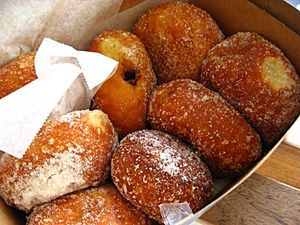
One popular Portuguese tradition in Hawaii today is making malasadas. These are deep-fried pastries, like donuts but without holes or fillings, usually covered in sugar. Portuguese people from Madeira and the Azores first made them in Hawaii. They would use up butter and sugar before Lent by cooking malasadas. These pastries are an important part of "Terça-feira Gorda" (Fat Tuesday) in Madeira and the Azores, which is like Mardi Gras. In Hawaii, this day is called "Malasada Day" and has been celebrated since the 1800s.
Another popular tradition is the Holy Spirit Festival (Festa do Espírito Santo). Since 1901, it has been celebrated every May with a parade and a big meal. This three-day event is a traditional celebration that started in the Azores in the 1700s. It usually begins on a Friday night. On Saturday, religious statues are decorated. On Sunday, a young woman is chosen to be like Queen Isabel, a queen of Portugal. She and her group lead a colorful parade. The festival ends with a church service where a priest blesses meat and bread. Then, Isabel is crowned as the Holy Ghost Queen. A big feast follows, where food is served to everyone, showing a tradition of helping the poor. Foods at this feast often include malasadas, sweet bread (paodoce), bean soup, Portuguese sausages, and bowls of beef and fish marinated in wine.
The Ukulele
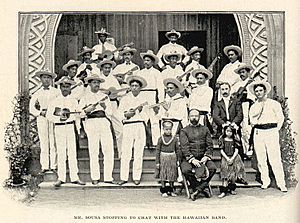
The most famous Portuguese gift to Hawaiian culture is the ukulele. This instrument is based on a traditional Portuguese instrument called the braguinha (or cavaquinho). The ukulele was brought to Hawaii by Madeiran cabinet makers Manuel Nunes, Augusto Dias, and José do Espírito Santo. They arrived in 1879 on a British ship called the SS Ravenscrag. Soon after they arrived, a Hawaiian newspaper reported that "Madeira Islanders recently arrived here have been delighting the people with nightly street concerts." The article also mentioned "their strange instruments, which are a kind of cross between a guitar and banjo."
The Journey to Hawaii
From 1878 to 1911, at least 24 different ships brought almost 16,000 Portuguese immigrants to Hawaii. Most came from Madeira and the Azores. Some also came from the eastern United States, mainland Portugal, and even from Montevideo, Uruguay.
The first Portuguese arrivals from Madeira and the Azores traveled for up to three months on crowded sailing ships. The journey was dangerous, with strong currents in the Atlantic and rough seas around Cape Horn at the tip of South America. When the SS Ravenscrag arrived in 1879 after 123 days at sea, three children had died during the trip. Even three years later, when the first group arrived by steamship on the SS Monarch in 1882, after 57 days, 13 children had died. Conditions on ships improved a lot after 1882 as more immigrants came by steamship.
| Ship Name | Type of Vessel | Flag | Arrival Date | Port of Origin | Days at Sea | Men | Women | Children | Total |
|---|---|---|---|---|---|---|---|---|---|
| Priscilla | Bark | German | 30 September 1878 | Funchal, Madeira | 116 days | 80 | 40 | 60 | 180 |
| Ravenscrag | Clipper | British | 23 August 1879 | Funchal, Madeira | 123 days | 133 | 110 | 176 | 419 |
| High Flyer | Bark | British | 24 January 1880 | São Miguel, Azores | 99 days | 109 | 81 | 147 | 337 |
| High Flyer | Bark | British | 2 May 1881 | São Miguel, Azores | 130 days | 173 | 66 | 113 | 352 |
| Suffolk | Bark | British | 25 August 1881 | São Miguel, Azores | 102 days | 206 | 100 | 182 | 488 |
| Earl Dalhausie | Bark | British | 27 March 1882 | São Miguel, Azores | 113 days | 94 | 82 | 146 | 322 |
| Monarch | Steamship | British | 8 June 1882 | São Miguel, Azores | 57 days | 202 | 197 | 458 | 857 |
| Hansa | Steamship | British | 15 September 1882 | Azores | 70 days | 307 | 286 | 584 | 1177 |
| Abergeldie | Steamship | British | 4 May 1883 | Azores | 62 days | 264 | 190 | 484 | 938 |
| Hankow | Steamship | British | 9 July 1883 | Azores (São Miguel) & Madeira | 66 days | 427 | 317 | 718 | 1462 |
| Bell Rock | Steamship | British | 1 November 1883 | Azores | 76 days | 396 | 294 | 715 | 1405 |
| City of Paris | Steamship | British | 13 June 1884 | Azores (São Miguel) & Madeira | 74 days | 295 | 199 | 330 | 824 |
| Bordeaux | Steamship | British | 3 October 1884 | Madeira | 72 days | 273 | 173 | 262 | 708 |
| Daca | Bark | British | 19 January 1885 | Madeira | 114 days | 63 | 50 | 165 | 278 |
| Stirlingshire (Sterlingshire) |
Clipper | British | 4 March 1886 | Madeira | 112 days | 157 | 107 | 203 | 467 |
| Amana | Steamship | British | 23 September 1886 | Funchal, Madeira | 142 days | 146 | 116 | 239 | 501 |
| Thomas Bell | Bark | British | 13 April 1888 | Madeira | 156 days | 117 | 62 | 163 | 342 |
| Braunfels | Steamship | German | 4 April 1895 | Ponta Delgada, Azores | 68 days | 274 | 124 | 259 | 657 |
| Victoria (Parthia) | Steamship | British | 13 September 1899 | Madeira | 67 days | 215 | 56 | 72 | 343 |
| Warrimoo | Steamship | New Zealand | 24 December 1900 | Vancouver, U.S. | 10 days | 60 | 14 | 18 | 92 |
| Aorangi | Steamship | New Zealand | 16 February 1901 | Vancouver, U.S. | 8 days | 9 | 7 | 7 | 23 |
| Suveric | Steamship | British | 1 December 1906 | Uruguay (Montevideo) & Azores (Fayal) | 52 days | 459 | 283 | 582 | 1324 |
| Kumeric | Steamship | British | 27 June 1907 | Funchal, Madeira | 58 days | 333 | 306 | 475 | 1114 |
| Swanley | Steamship | British | 14 December 1909 | Azores (P Delgada) & Madeira (Funchal) | 49 & 55 days | 337 | 221 | 310 | 868 |
| Orteric (Osteric)* | Steamship | British | 13 April 1911 | Portugal (Oporto & Lisbon) and Gibraltar | 48 days (from Gibraltar) |
547 | 373 | 531 | 1451 |
| Total | 16,929 |
Famous Hawaiians with Portuguese Roots
Portuguese sailors probably visited Hawaii as early as 1794. The first Portuguese immigrant officially recorded was Dr. João (John) Elliott de Castro, who arrived in 1814. He became the personal doctor for King Kamehameha I. Since then, many Hawaiians with Portuguese ancestry have become famous. Here are a few:
- Stephen Peter Alencastre (1876–1940), a Catholic Bishop of Hawaii.
- John Gaspar Machado (1846–1937), who built Hawaii’s first important coffee mill in 1880.
- Bryan Baptiste (1955–2008), a former Mayor of Kauai.
- Brennen Carvalho (born 1985), a football player.
- Bernard Carvalho (born 1961), a former Mayor of Kauai and former professional football player.
- Auliʻi Cravalho (born 2000), an actress known for her role in the Disney movie Moana.
- Wesley Correira (born 1978), a professional mixed martial arts fighter.
- Frank De Lima (born 1949), a comedian.
- Frank Ferera (1885–1951), a ukulele and Hawaiian steel guitar player.
- Sid Fernandez (born 1962), a professional baseball player.
- Kurt Gouveia (born 1964), a professional football player.
- Manuel Henriques (1888–1974), a former Vice Speaker in the Hawaiian House of Representatives.
- Billy Martin (1928–1989), a baseball manager whose father came from the Azores.
- Glenn Medeiros (born 1970), a singer and songwriter.
- Leroy A. Mendonca (1932–1951), who received the Medal of Honor after he died in the Korean War.
- Ernest Morgado (1917–2002), a businessman who created huli-huli chicken.
- Prince Oana (1910–1976), a professional baseball player.
- Bobo Olson (1928–2002), a professional boxer.
- Jonah Ray (born 1982), a comedian.
- Clarence Richard Silva (born 1949), a Catholic Bishop of Honolulu.
- Freddie Tavares (1913–1990), who helped design the Fender Stratocaster guitar.
- Kanekoa Texeira (born 1986), a former professional baseball player and coach.
- Shane Victorino (born 1980), a professional baseball player.


